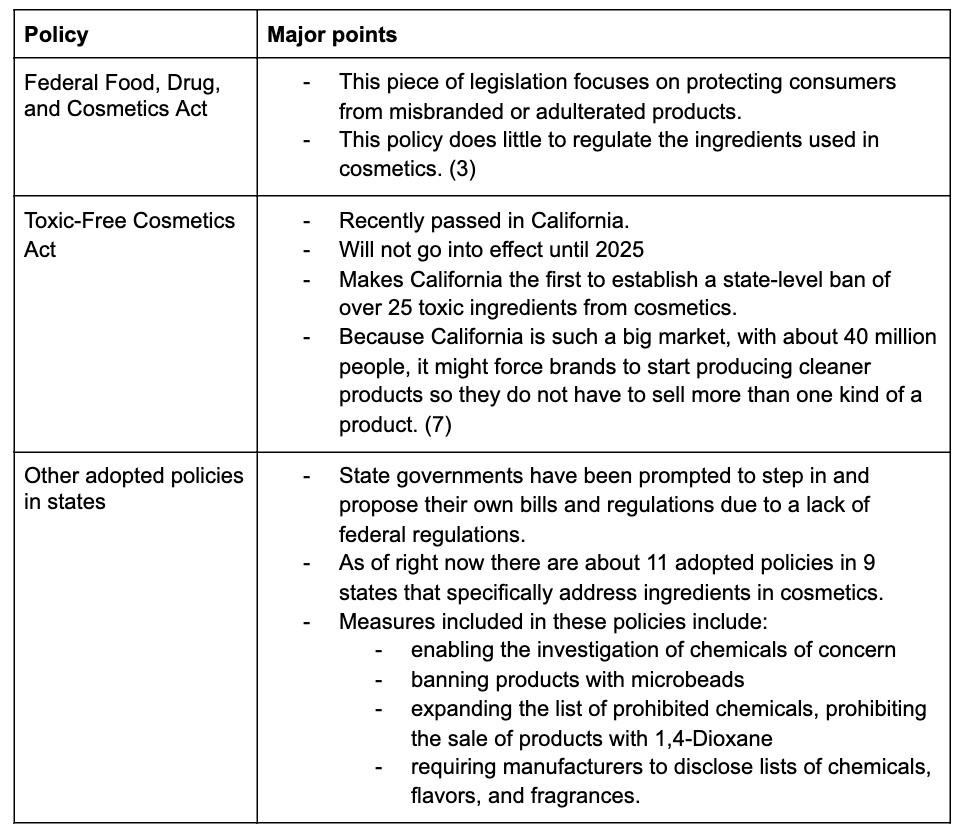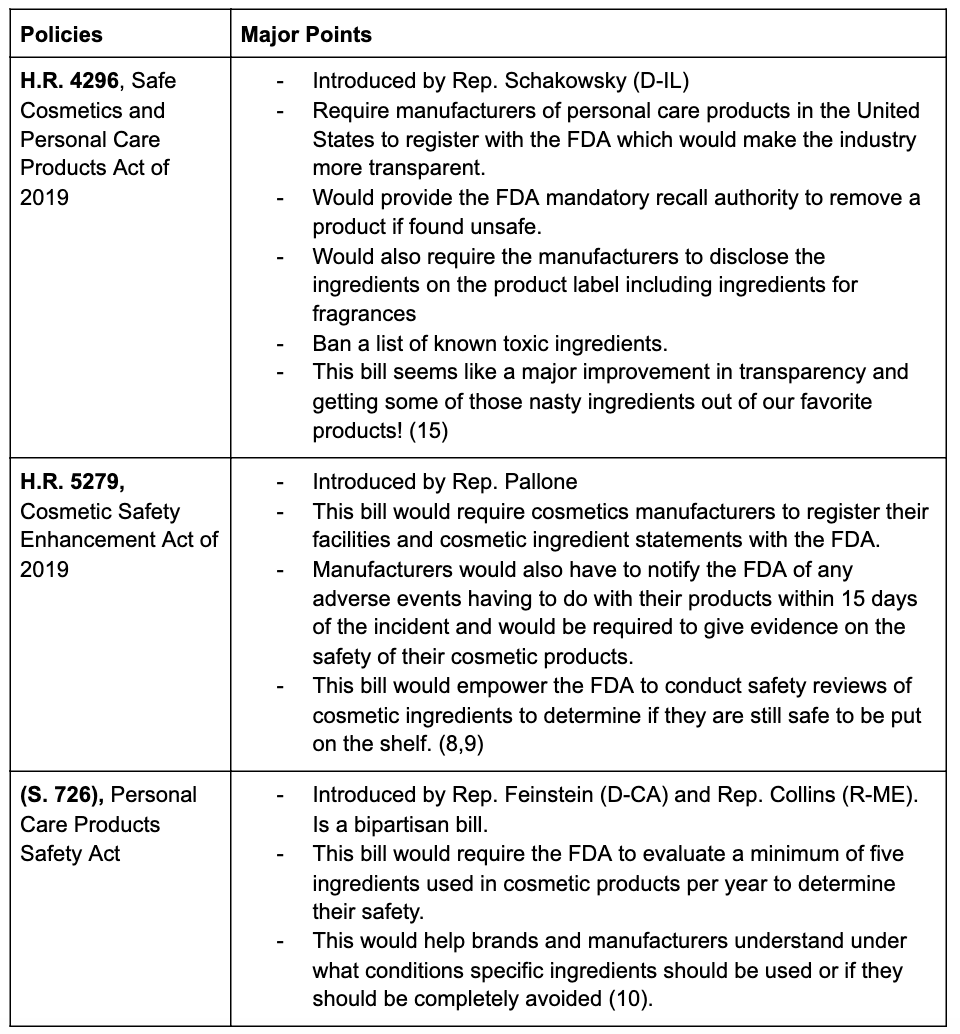What’s the Deal with Clean Beauty Regulations?
The current regulations in the cosmetics industry and some hope for cleaner products
When you walk into a cosmetics store what section do you go to first? The makeup, the skin care, maybe the hair care? By the time most of us are done and have gone through the entire store it’s been two hours and our hands are full of different swatches of nude lipsticks, gold eyeshadows (somehow they are all slightly different), eyeliners, and maybe even a few perfumes on each arm. Cosmetics products are a staple in everyone’s lives, but something most people might not be aware of is how many ingredients go into making our favorite cosmetics products like foundation or lip gloss. There’s a lot of ingredients and magic that go into making foundation that gives you that perfect dewy skin look or lip gloss that is the perfect balance of sparkly and not too sticky. Due to the lack of government regulation of the ingredients in cosmetics products, there are all sorts of ingredients that are known to cause harm to humans in our makeup, lotions, deodorants, hair care, and the myriad of other cosmetic products. This issue on toxic ingredients has sparked a huge growth in cosmetic products that are labeled as “clean”. Have you ever heard of clean beauty? Is it just a trend? Keep reading to explore what clean beauty is and some of the current and upcoming cosmetic regulations!
The problems with unregulated cosmetics
With the exception of hair dye, there are no laws that require cosmetic products or ingredients to be approved by the FDA before they go on the market. The FDA does not require specific safety tests to be done on a product or ingredient meaning only the individuals who manufacture and market the cosmetics have a legal responsibility to ensure the safety of their products. This is a major problem! Because manufacturers are not required to test for safety, consumers do not know if they did these tests at all or if the testing they did was adequate (4). To make matters worse, if a product eventually appears to have an adverse effect, the FDA has no authority under the current regulations to force the company to recall the product, the company must do so voluntarily (12). Between the years 2004-2016, an average of 396 adverse events per year were submitted to the FDA (11). If the objective is to keep people safe, this is too little too late!
Some common toxic ingredients in typical cosmetics products are heavy metals, PFAS (a group of Teflon-like chemicals), parabens, petroleum, phthalates, and fragrances. Heavy metals like lead, arsenic, mercury, zinc, chromium, and iron are often used for coloring purposes in cosmetics from lipstick to eyeliner. They can also accidentally end up in products due to contamination during the manufacturing and packaging processes (1,17). PFAS chemicals are often found in a lot of products like pressed powder makeup, foundation, anti-aging lotions, eyeliner, eyeshadow, mascara, and lipstick (1,16). PFAS gives cosmetics a waterproofing ability along with giving it a really smooth texture on the skin (2). Parabens are a synthetic preservative that is added to cosmetics to last longer, and petroleum, a byproduct of oil refining, has a really long shelf life and softens upon use making it a beneficial addition to cosmetics. The last two common ingredients are phthalates and fragrances which often go hand in hand. Fragrances are obviously placed in a product to make it smell better (1). They can be made from petroleum or natural materials, but most of the time the entire ingredient lists are not given due to it being proprietary information for the brand. Many fragrances then add in phthalates as a solvent to make the scent stick around longer. Phthalates are used mainly in cosmetics as skin moisturizers, skin softeners, skin penetration enhancers, and as anti-brittleness and anti-cracking agents for nail polish (18).
These ingredients are known to be endocrine disruptors, and are linked to reproductive and developmental harm, allergies, and even cancers (1,19). We should also keep in mind that we could be exposed to more than one toxic ingredient everyday depending on how many cosmetic products we use. When used repeatedly, ingredients like PFAS and the different heavy metals can accumulate in our bodies over time and increase our risk for illness (1).
In addition to being hazardous to our health, these same ingredients can also be toxic to our environment. Everytime you throw something away or wash it down the drain, those chemicals are going back into the environment polluting our soil and waterways (5). It’s the same as chemicals coming off of your car and polluting the environment: a toxic chemical is a toxic chemical no matter where it came from!
What clean beauty means
The term “clean beauty” is pretty subjective, but it usually means that the products contain ingredients that have been evaluated for safety and the brands are transparent about the ingredients they are using. More and more brands have been coming out with clean cosmetic products because they realized that a lot of the everyday products people use have harmful and toxic chemicals in them. Some of these brands have a list of chemicals they refuse to use like parabens, synthetic fragrances, sulfates, phthalates, and more. There are even some clean beauty retailers that require brands to disclose all of their ingredients and check them against a do not use list before they are allowed to be sold. This all seems like progress, but all of these actions are voluntary and not required under law, meaning most brands don’t go that extra mile which is why there’s an urgent need for new government regulation and policies for the skincare industry.
Clean Beauty Regulations
The current federal regulations are pretty lackluster. For some context, the EU has prohibited the use of 1,378 substances in cosmetic products compared to the United States which has only banned 11 substances (13,14). Some of these banned chemicals include chloroform, mercury compounds, vinyl chloride, chlorofluorocarbons, and a few others (14). This abysmal effort by the federal government has forced states to come in to propose more comprehensive safety regulation for cosmetics. One particular bill recently passed in California, has established a ban of 25 toxic ingredients in cosmetics which could have major impacts on the cosmetics market as a whole. Because California is such a big market, with about 40 million people, it might force brands to start producing cleaner products. Most brands don’t want to create two separate products, one cleaner version for people living in California, and another that is suitable for the rest of the U.S.! So there is hope that this bill in California could push brands to only create clean products. There are also a few other states including Connecticut, Colorado, Maine, Maryland, New York, Oregon, Vermont, Minnesota, and Wisconsin that have adopted policies to start cleaning up the cosmetics sold in their states (6).

Upcoming Clean Beauty Legislation
In the past few years there have been three big pieces of federal legislation that have been introduced into congress along with 9 state policies introduced by Maryland, New Jersey, and New York. Most of these state and federal policies focus heavily on removing the toxic ingredients and giving the FDA more authority to recall a product and to do their own safety reviews. These policies have not been passed or turned into law, but if all goes well they will be on their way to pass in the next few years!

Why switch to clean beauty?
Switching to clean beauty products can be a great way to start limiting our exposure to toxic chemicals. But as we previously mentioned, there is no universal clean beauty standard, or list of ingredients brands need to avoid. There is very little regulation on ingredients across the entire cosmetics industry, meaning products can claim they are safe but that could mean entirely different things depending on the brand. For the most part switching to clean beauty products is likely to reduce your overall exposure to toxic ingredients because these brands have tried to reduce the number of chemicals in their products. Brands like Sephora and Target now have clean beauty sections that people can shop from, along with stores and brands like Detox Market, Follian, Credo, BeautyCounter, Ursa Major, and Biossance to name a few. These stores and brands have made it so we don’t have to wait around for government regulation to get cleaner cosmetics products. If you can, try to support more clean beauty brands to show the world that there is a market and a need for cosmetic products that don’t put us at risk!
Resources to support and keep updated on clean beauty legislation
We created a list of letter writing campaigns, clean beauty news sources, and information pages on current and upcoming clean beauty legislation. If you want to stay updated on clean beauty legislation and find ways to support the different state and federal policies, click on the links below!
- This link allows you to send a message to your congressional representative to support the Safe Cosmetics and Personal Care Products Act of 2019 (H.R. 4296)!
- The Campaign for Safe Cosmetics has an action alert page with multiple letter writing campaigns to tell your cosmetics companies, the FDA, and elected officials that safe cosmetics are important to you. Click the link here!
- The Environmental Working Group has a page dedicated to clean cosmetics legislation, news and reports, and where to support clean cosmetics companies.
- The Campaign for Safe Cosmetics tracks upcoming and adopted state policies in regard to cosmetics and cleaning products.
Sources
- https://www.safecosmetics.org/get-the-facts/chem-of-concern/
- https://www.ewg.org/skindeep/contents/is-teflon-in…
- https://www.law.cornell.edu/uscode/text/21/chapter-9/subchapter-VI
- https://www.fda.gov/cosmetics/cosmetics-laws-regulations/fda-authority-over-cosmetics-how-cosmetics-are-not-fda-approved-are-fda-regulated
- Juliano, C., & Magrini, G. A. (2017). Cosmetic Ingredients as Emerging Pollutants of Environmental and Health Concern. A Mini-Review. Cosmetics, 4(2), 11. https://doi.org/10.3390/cosmetics4020011
- https://www.saferstates.org/toxic-chemicals/cleaning-cosmetics-and-construction/
- https://leginfo.legislature.ca.gov/faces/billTextClient.xhtml?bill_id=201920200AB2762
- https://energycommerce.house.gov/committee-activity/hearings/hearing-on-building-consumer-confidence-by-empowering-fda-to-improve
- https://energycommerce.house.gov/sites/democrats.energycommerce.house.gov/files/documents/COSMETICS_DRAFT%20112719.pdf
- https://www.feinstein.senate.gov/public/index.cfm/2019/3/feinstein-collins-introduce-bill-to-strengthen-oversight-of-personal-care-products
- Kwa, M., Welty, L. J., & Xu, S. (2017). Adverse Events Reported to the US Food and Drug Administration for Cosmetics and Personal Care Products. JAMA Internal Medicine, 177(8), 1202–1204. https://doi.org/10.1001/jamainternmed.2017.2762
- https://www.fda.gov/cosmetics/cosmetics-recalls-alerts/fda-recall-policy-cosmetics
